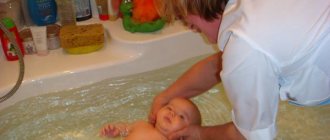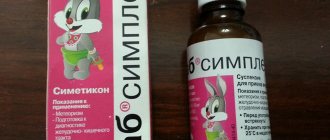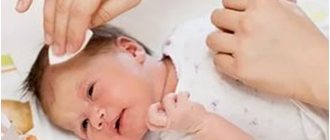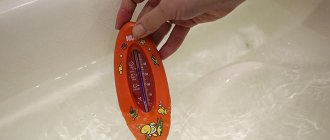At the time of birth, the baby's umbilical cord is cut, the remainder of which usually falls off 3-5 days after this, and the umbilical wound itself should heal by the end of the first month of life so that there are no crusts or purulent discharge left in its place.
In practice, not all umbilical wounds heal quickly and without complications; sometimes a newborn’s navel continues to bleed or fester even several weeks after birth. This situation causes concern among parents and becomes a reason to consult a doctor.
How long does it take for a newborn's belly button to heal?
During the first 3-4 days, the residue, if any, gradually dries out. Then the remainder falls off. This action occurs independently and there is no need to interfere with this process. The umbilical cord, as a rule, disappears on the 3rd day and this fact does not depend on the height, weight, or gender of the baby. Over the next 7 - 20 days, the wound itself dries out, and on days 21 - 28 you can see a completely healed navel. Children are individual, and therefore the time frame for healing of the navel may vary, but if there is a delay in healing by at least 3 days, then you should immediately consult a pediatrician.
How to properly treat a newborn's navel
Recently, some doctors have recommended a method of treating the navel with only water and cotton swabs. Such doctors are categorically against brilliant green and other antiseptics. Many specialists are perplexed by this approach, and they subject it to strong criticism. Cotton swabs by themselves are not sterile, and pathogenic microbes can remain in boiled water. In addition, plain water is not a bactericidal agent and will not dry out the umbilical wound. Therefore, mothers should think more than once before trusting such an erroneous opinion and doing without antiseptics.
An antiseptic is applied to the navel of a newborn at least once a day. If there are no complications or deviations, then these procedures will take an average of 2 to 3 weeks.
Doctors advise using the following antiseptic medications to treat the wound:
- hydrogen peroxide solution (3%);
- brilliant green solution (1%);
- ethyl alcohol (70%);
- chlorophyllipt solution;
- potassium permanganate solution (5%).
Chlorophyllipt is especially valued among doctors. After all, it does not have a pronounced color like brilliant green or potassium permanganate. Therefore, if the inflammatory process begins, it will be noticeable immediately. In rare cases, experts may recommend using arnica powder to heal the navel. This product is also an antiseptic, and also has a quick drying property. If the navel is treated with this powder, then you need to put a sterile bandage on it and put on a medical mesh to secure it. When the navel does not go away for a long time (it bleeds or gets wet), doctors may prescribe the drug Baneocin . But this remedy cannot be used for more than a week.
The best time to treat the navel is after water procedures. Typically, bathing a newborn is done in the evening before bed. It is recommended to boil water for bathing a newborn. It should be remembered that adding a decoction of herbs or other herbs to raw bathing water does not guarantee its disinfection. Rather, herbal decoctions are added as additional ingredients for the prevention of diaper rash (chamomile, nettle) and colic (hop cones, motherwort), as well as calming the baby before bed (lavender, mint). In this case, potassium permanganate can be added to the water as an antiseptic. After bathing, the crust will soften and it will be much easier to handle.
How to carry out the navel treatment process:
- First, the mother or other family member who will carry out the cleaning procedures needs to wash their hands with soap.
- The treatment most likely takes place after bathing, so you should carefully and very delicately blot the navel area with a soft towel, or better yet, a flannel diaper. A clothespin on the belly button can complicate this process. In this case, you should carefully blot and dry the area under the clothespin to prevent your navel from getting wet.
- Take a few drops of hydrogen peroxide into a pipette and drop it onto your navel. If there is a clothespin, then you need to carefully tilt it to the side so that the drops of peroxide fall exactly on the area of the navel and the existing appendage. If you wait a while, the peroxide may begin to foam. There is nothing scary in this process. The hissing of peroxide will be observed until the baby receives a completely healed navel.
- With a cotton swab, you should very carefully remove that part of the crusts that comes off well. Under no circumstances should you forcibly tear off the scabs and insert the stick deep into the wound. The moment will come and all the crusts will come off the navel.
- You can drop another drop of peroxide and wait for it to dry.
- Moisten a new cotton swab with brilliant green and blot the navel area with it.
Until the wound on the navel heals, it is forbidden to touch this area with your hands. In this way, you can very quickly introduce microbes onto it, which in turn will quickly penetrate the child’s bloodstream and lead to complications.
If a newborn’s navel does not heal for a long time, and purulent discharge is also visible, then you should immediately seek help from a specialist.
A very common reason why a newborn's navel does not go away for a long time is injury from a diaper. Firstly, the diaper may rub against the belly button, causing damage, and secondly, it may be very congested with urine, which leaks towards the belly button. To avoid such problems, you need to change the diaper as it gets dirty, on average every 3 hours for a newborn, and also make sure that it does not touch the navel area (purchase diapers with a special umbilical notch for the first month, or bend the front edge of a regular diaper).
What to do when a newborn’s belly button bleeds?
It is acceptable if the navel bleeds in the first days after removal of the umbilical cord. But when the navel does not heal for a long time and bloody discharge is also visible, then you should pay more careful attention to this fact and perhaps reconsider the hygiene procedures for the newborn. Perhaps mom made a mistake somewhere.
Common reasons why the navel bleeds:
- The baby's navel does not heal because it does not have enough air baths and the wound simply does not have time to dry out.
- It is possible that the baby has a wider navel, and this circumstance contributes to the fact that it takes more time to heal than a wound from a narrower umbilical cord.
- The wound is injured by a disposable diaper.
- The navel of a newborn may not heal due to poor-quality cutting of the umbilical cord.
- It is possible that parents are rushing things and placing the baby on their tummy. Experts recommend laying out no earlier than the baby is three months old.
- The navel may not heal for a long time if the mother is very zealous with its treatment and forcibly removes more crusts than she should. Thus, some tissues do not have time to dry out, while others do not have time to form.
- When treated with cotton swabs, a very small lint may remain in the navel, thereby contributing to the inflammatory process. In this case, the newborn’s navel will not heal for a very long time.
- The baby's immune system is weakened.
- There may be an umbilical hernia present.
If parents notice that the newborn’s belly button is bleeding heavily and an extremely unpleasant odor is felt, then these are signs of incipient inflammation. You should seek help from your pediatrician as soon as possible.
When the navel bleeds due to improper hygiene, then by eliminating possible errors in the treatment of the navel and proper access of air to the wound, it will soon heal. If the baby has a weakened immune system, has a hernia or a foreign body in the wound, then medical help cannot be avoided. In cases where blood is still oozing from the navel on the 21st day of cord cutting, you should pay attention to whether there are other symptoms. Namely:
- increased temperature and swelling in the navel area;
- unpleasant odor and possible discharge of pus;
- strong protrusion of the navel.
If you detect at least one symptom, you should immediately consult a doctor for treatment.
Navel care in the maternity hospital
The umbilical cord is ligated in two stages. First, 2 sterile surgical clamps are applied to it directly in the delivery room. The area of the umbilical cord between them is treated with an antiseptic and then cut with sterile scissors. After this, at a distance of 3 mm to 1 cm from the umbilical ring, the umbilical cord is clamped with a special bracket or tied with a ligature - silk thread. The remainder of the umbilical cord is cut off with sterile scissors.
Then there may be two options. Doctors either use the method of surgically cutting off the remnants of the umbilical cord on the second day of the child’s life, or the remnant of the umbilical cord is not cut off, but dries up and falls off spontaneously within a few days (with this method, the applied bracket is not removed).
If the baby and mother were separated in the maternity hospital for medical reasons, the umbilical cord will be treated with brilliant green. If mother and baby have been together since birth, both WHO and the Ministry of Health of Ukraine recommend simply keeping the navel clean, not covering it with diapers and carefully monitoring its condition.
Source: Shutterstock
What to do if your navel gets wet
Often, a weeping navel can be observed due to non-compliance with hygiene rules. Eg:
- Non-sterile materials were used during processing.
- Water procedures are carried out in unboiled water.
- Mom's hands were dirty when processing.
- The baby's clothes are rough or poorly ironed.
When the wound gets infected, this leads to the fact that the navel does not heal for a long time. At the same time, liquid begins to accumulate in it, and as a result, it gets wet. Increased humidity in the navel area provokes redness of the skin around it, swelling, development of pus under crusts and soreness in this part. When this unpleasant situation begins to progress, you should consult a doctor for the right treatment. As a rule, the doctor will advise sanitation of the navel more than once a day; treatment may be needed every 2-3 hours. When the navel gets very wet, the place of hydrogen peroxide will be taken by Baneocin powder, potassium permanganate, alcohol solution or streptocide. Before using these products, the wound should be rid of pus and excess fluid. Air baths need to be performed more often than usual and for longer periods of time. Mom should not neglect the advice and recommendations of the doctor, otherwise you can get serious complications in the health of the baby. It could be:
- Sepsis is blood poisoning.
- Peritonitis is an inflammatory process of the abdominal cavity.
- Omphalitis is an inflammatory process due to infection of the umbilical wound.
In this case, you cannot self-medicate.
The baby was born. When is the umbilical cord cut?
Soon after the baby's first independent breath, blood flow through the umbilical vessels stops, and the baby's body begins to function independently of the mother's body.
After the baby is born, doctors clamp the umbilical cord on both sides with special clamps and then cut it. And if earlier this was done literally in the first seconds after the baby was born, now there is no rush with this procedure. The fact is that specialists from the World Health Organization have found through research that within 60 seconds after birth, 80 ml of blood from the placenta enters the baby’s body, and after another 2 minutes – 100 ml. It is this blood that is an additional source of iron for a newborn, sufficient to provide him with this element for a whole year. So now in maternity hospitals in America and Europe they practice the so-called “late” cutting of the umbilical cord - after the pulsation in it has completely stopped, about 2-3 minutes after the birth of the baby.
Source: Shutterstock
What does a healed baby's navel look like?
There is no clear answer to the question “How long does it take for a newborn’s navel to heal?”, since this period is considered individual for each case. Usually, by the age of two months, and often much earlier, the baby’s navel is completely healed. At the same time, it does not stand out in color from the rest of the tissues of the tummy, does not bleed, does not emit moisture and does not shine, and its contours have a clear and smooth surface.
Sometimes parents begin to sound the alarm when they see that the healed navel is sticking out very much. If protrusion occurs only when crying or straining, then most likely it is a hernia, which will go away over time as soon as the muscles get stronger and return to normal. No special treatment is required. If the navel protrudes all the time and there is skin surrounding it, then this is a feature of the navel that does not require treatment.
Why is an umbilical cord needed?
The umbilical cord (lat. funiculus umbilicalis, umbilical cord) is a special organ that provides connection between the fetus and the mother through the placenta. The main function of the umbilical cord is to supply the fetus with nutrients and remove metabolic products. Its basis is blood vessels: 2 arteries and a vein. Arterial blood flows through the umbilical vein, carrying oxygen to the fetal organs, and venous blood flows through the arteries, from the fetus to the placenta, it carries metabolic products. A peculiarity of the umbilical cord vessels is that they are located in a gelatinous substance - “Wharton’s jelly”. Such protection fixes them and protects them from injury, and also carries out the exchange of substances between the fetal blood and amniotic fluid.
Also present in the umbilical cord is the vitelline duct, which carries nutrients from the yolk sac to the fetus, and the urachus, a connecting canal between the placenta and the bladder.
The formation of the umbilical cord begins at 2 weeks of pregnancy. As the fetus grows, this organ also enlarges, eventually reaching a length of 60-70 cm and a diameter of about 2 cm.
Thanks to the umbilical cord, the unborn baby receives all the substances necessary for growth and development. Also, through this organ, cleansing functions are carried out through the placenta, since the baby’s liver is not yet able to cope with it.










